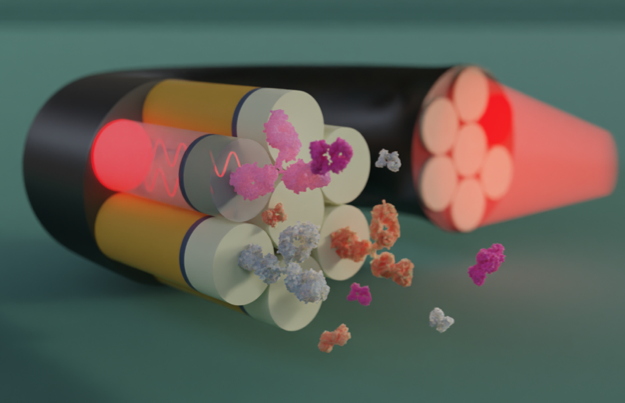PhD proposal - financed by the IRGA project AMIS (In Situ Molecular Analysis) Funding of the salary and the environment.

Artistic view of the proposed biosensor
 Context:
Context:The objective of the AMIS research project is to contribute to the development of innovative biosensors capable of performing real-time, remote,
in situ and multiplexed molecular analysis intended to eventually replace biospies, which are time-consuming and invasive procedures. Based on our experience with fiber-based plasmonic biosensors
1,2,3, we propose to develop these biosensors on an interferometric optical fiber assembly (Fig.1). A preliminary work allowed us to determine the optical indexes and the thicknesses of the interferometric layers to be deposited at the end of the fibers to confer them a sensitivity to the variations of optical indices. These results allowed us to prepare different samples (glass slides, mono-fibers, multi-fibers, multi-core fibers) covered with
ad hoc interferometric layers.

Figure 1 - A) Physical principle. B) Fiber inserted in a needle.
C) Example of a multicore fiber (12 cores, iXblue)
 Role of the PhD student:
Role of the PhD student:The PhD student will start by taking in hand these different samples by characterizing their resolution and their sensitivity to optical index variations. This characterization will allow him/her to become familiar with the optical setup, to perform measurements (spectral analysis and intensity measurements) and to process the associated data. He/she will then work on the implementation of new optical functionalization methods4
4. The aim will be to determine the protocols for functionalizing the ends of the fibers on several distinct zones with diameters of about 10 µm (for fiber assemblies with diameters between 300 µm and 3 mm). The PhD student will deal with both optical aspects (optical assembly, UV irradiation) and surface chemistry
5 (preparation and grafting of probes). This will require the development of multidisciplinary skills in chemistry and optics. He/she will of course be accompanied by the physicists and biochemists of the CREAB team to advance in this development which will constitute an important part of his/her thesis work. The other important part will concern the biological validation of the sensor. Once functionalized, it will have to demonstrate its multi-detection capabilities. To do so, the PhD student will perform detections of several biological targets in more and more complex and "solid" environments. It will be necessary to implement robust passivation methods to avoid non-specific detections or even a progressive passivation of the sensor. The PhD student will be accompanied in this task by the BrainTech Lab researchers involved in the project. The final objective will be to achieve a multiplexed detection of biomarkers of interest in a brain tissue model.
 Skills developed:
Skills developed:During this thesis, the PhD student will acquire or reinforce his/her skills in optical instrumentation, theoretical optics, image processing, surface chemistry, biochemistry in the very multidisciplinary context of biosensors.
 References :
References : [1] Vindas, K.,
et al.
Enhanced sensitivity of plasmonic optical fiber sensors by analyzing the distribution of the optical modes intensity. (2020) Optics Express Vol. 28, Issue 20, pp. 28740-28749.
doi.org/10.1364/OE.399856 [2] Desmet, C.,
et al.
Multiplexed Remote SPR Detection of Biological Interactions through Optical Fiber Bundles. (2020) Sensors, MDPI, Vol 20 (2), p.511.
doi.org/10.3390/s20020511 [3] Vindas, K.,
et al.
Highly-Parallel Remote SPR Detection of DNA Hybridization by Micropillar Optical Arrays. (2019) Analytical and Bioanalytical Chemistry, Vol 411, p2249-2259
doi.org/10.1007/s00216-019-01689-2 [4] Alvarado Meza, R.,
et al.
Optically Assisted Surface Functionalization for Protein Arraying in Aqueous Media. (2017)
Langmuir 33, 10511-10516
[5] Dendane N.,
et al.
Efficient Surface Patterning of Oligonucleotides Inside a Glass Capillary through Oxime Bond Formation. (2007) Bioconjugate Chem. 18, 671
doi.org/10.1021/bc060254v Other information:Contact
Other information:Contact:
Élodie BidalCo-supervisors: Loïc Leroy and Arnaud Buhot
Start and duration of the thesis: October 2023, 36 months
Location: CEA-Grenoble, scientific polygon
https://www.cea.fr/Pages/le-cea/les-centres-cea/grenoble.aspxLaboratory:
SyMMES,
Team:
CREAB,
Required documents for candidates: CV, covering letter, recommendation letter(s)